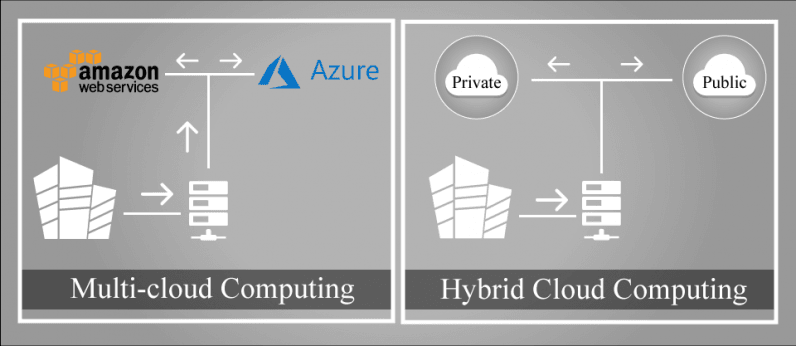
The cloud is mainstream but that’s old news. Cloud technology has been evolving and introducing better innovative solutions to enterprise requirements. Initially, with Amazon leading the pack, it was just AWS (Amazon Web Services) and S3 (Simple Storage Service).
The cloud market has come a long way from there and it didn’t take much time either. I’d say innovation is a lot faster now than it used to be. Before long, cloud storage wasn’t the only solution available. Backup and disaster recovery industries soon followed and now we have a ton of available cloud technologies in the market.
The two computing models that I want to explore in this article are: Hybrid-cloud and multi-cloud. Coming out of 2017, these two computing models were the talk of the entire industry. Neither of them is new but the implementation of both of them is now more favorable for the enterprise than ever before.
Before discussing the two, I’d like to clarify both of them. There’s an understandable amount of confusion associated with hybrid and multi-cloud computing models. This is due to the fact that both terms are used interchangeably. I find the two models to be quite different, so I try to emphasize on the unique nature of both of these models more.
What are hybrid cloud and multi-cloud computing models? And how are they different from one another?

A picture can tell a lot more, so I’ll rely on my vector manipulating skills using Figure 1. On the left hand side, there’s an enterprise sending their data to an infrastructure with cloud connect services. This infrastructure then uses these services and sends this data to the cloud. To this point, both computing models are the same.
What’s unique about the left hand side? Well, it’s showing that the data is moving to two public clouds, as an example (Azure and AWS). Meanwhile, the right hand side displaying hybrid cloud computing shows that the data is being distributed to private and public clouds.
Multi-cloud computing, as the naming literally suggests more than one cloud is exactly that. When an enterprise uses more than one public cloud for their data storage, backup and/or disaster recovery; they’re basically using a multi-cloud solution.
While hybrid cloud computing uses two types of clouds: Private cloud and public cloud.
One thing to note here is that hybrid cloud specifically refers to this collection of private and public clouds while the term hybrid solution is broader in scale; while interesting, we’re really not discussing hybrid solutions, so let’s not indulge in that, just know that hybrid cloud is a subset of hybrid solutions.
That’s the basic difference between these two computing models; I hope that’s cleared up. Now, why do enterprises need them more than ever before?
Good question, let’s look into that.
Why enterprises need hybrid cloud and/or multi-cloud computing models more than ever before
Allow me to address the use of “and/or” in the subheading first. As there’s constant mixing up of the two computing models, I’m sure it wouldn’t surprise you to know that it is assumed to be an either/or situation in some circles. However, that’s really not the case.
An enterprise can make use of both cloud computing models; it depends on the data requirements of the enterprise. For instance, an enterprise can use a cloud gateway appliance and use public clouds (Azure and AWS) while using another appliance and using its cloud connect services to tap into a private cloud.
The wonders of the multi-cloud computing model
The first advantage of multi-cloud clouds is vendor lock-in prevention. Vendor lock-in is also a term that has re-emerged recently. IT professionals began emphasizing on how bad lock-ins proves for them sometimes. In some scenarios, vendor lock-ins really acts as the chains that prevent your enterprise from fully benefiting from a cloud based solution.
For instance, consider an enterprise using Microsoft Azure storage. If the enterprise has to expend resources to properly manage, classify, and monitor their stored their data, they have to rely on Microsoft’s services while Amazon on the other hand is offering a machine learning service (Amazon Macie); that’s artificially intelligent and does this for them. The enterprise using Microsoft Azure can only stare from a distance and see the AI work for Amazon users. With multi-cloud solutions, they do not have to go through that painful ordeal.
Another fun advantage of multi-cloud is that due to its architecture, it introduces a unique kind of geo redundancy. Enterprises can choose to access different data centers within different regions and store their data. This isn’t simply geo redundant but also far more secure. That means additional recoverability, redundancy, privacy, and data security.
A while ago, I read an interesting perspective about multi-cloud computing model. While the writer specifically mentioned that multi-cloud storage is not the same as a disaster recovery, he pointed out an interesting resemblance between both of them. Disaster recovery basically allows enterprises to failover to a replicated system in case of hardware failure or the outage of a cloud service provider. Multi-cloud services can help in a similar scenario as well.
Let’s say you are using Microsoft Azure and Google for your data storage. For some reason, Azure goes down and you cannot access your stored data. You can simply use your Google storage instead. You won’t even feel the difference compared to the person relying on Azure only in this instance.
However, I would like to point this out as well. Multi-cloud model does give the impression that it facilitates failover but it does not equate to a well-developed disaster recovery service and plan. You cannot have reduced RTOs (Recovery Time Objectives) and RPOs (Recovery Point Objectives) with multi-cloud services but disaster recovery specifically target reduction of downtime and reduced RTPOs (RTOs and RPOs).
The perks of the hybrid cloud computing model
Hybrid cloud model presents a number of interesting options. In fact, one can combine both models using the hybrid cloud computing model. For instance, enterprises can use a hybrid cloud computing model to access private and public clouds; and they can use more than one public clouds using different services and/or appliances.
Apart from combining the two models, hybrid cloud gives access to the private cloud and public cloud. Enterprises can use public clouds for data storage, backup, archiving, and sharing but there’s always that risk of data leakage. In 2017, we witnessed a series of data leakage situations from public clouds. And I recently read a report by the BBC that made me think that we have yet to learn about proper public cloud usage when it comes to data privacy.
This data privacy concern is effectively addressed by hybrid clouds since you can keep your sensitive data in the private cloud. If the enterprise deploys a private cloud, then despite being in the cloud, the latency is reduced and data transmission within the cloud is smoother. So you get faster rate of transmission, data is available throughout the enterprise and is secure.
Using the two computing models
Due to the continuous global growth of enterprise data, the requirements are getting complex and the innovative solutions to these requirements tend to be quite vexing at times. If a large enterprise has to rely on big data and needs to keep it stored efficiently, then a combination of these two models promises to deliver on the enterprise requirement.
On the downside, the combination of these two computing models gets complex and requires effective data management policies to be put in place.
In the end, let’s see what an enterprise needs to do to effectively use these computing models:
- Analyze data – determine the importance, priority and access frequency
- Develop data management policies – to effectively leverage all kinds of enterprise data with the help of the previously collected information
- Develop a professional IT team to deploy and follow the data management policies
- Analyze the available cloud services available in the market
- Deploy the solution based as per the analysis and the policies
That concludes my insight on the article. Share your thoughts my commenting below. If you like what I’ve said about the subject, remember to share these thoughts with like-minded professionals.
Get the TNW newsletter
Get the most important tech news in your inbox each week.




